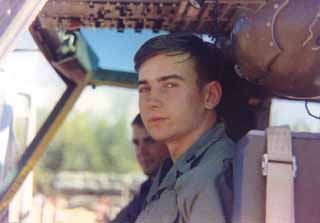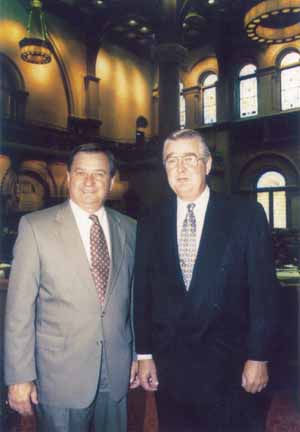
An American military helicopter delivers Special Forces troops behind enemy lines on an obscure mountaintop half a world away from home. Dateline Afghanistan 2001? No, Vietnam1969. A different millennium, a different enemy, a different type of war. One thing remains the same across the 30-year span –- young Americans answer the call of their country, training with pride and carrying out their orders to the best of their abilities. Hoping to return home safe. Hoping to return home to a country that appreciates their sacrifices. New York State Assemblyman Charlie Nesbitt was one of those Army helicopter pilots in 1969. Unlike many of his comrades, he returned home safely. But he hasn’t forgotten the sacrifices of his fellow soldiers and he works hard to make sure others don’t forget. Nesbitt grew up in an Albion family that had a strong tradition of military service. His father had served in the Navy. His father’s cousin was a highly decorated World War II Naval pilot. As a college freshman, Nesbitt was interested in enrolling in the Navy’s flight program. He missed a window of opportunity at the end of his first year of college, so he ended up signing with the Army flight program instead. It would have been easy for Nesbitt to stay in college and defer service, but he never really considered that an option. "I felt that if we were at war, I should do my part," Nesbitt said. "There were many others on college campuses that felt that way, but for the most part, they didn’t get the news coverage." As a 19 year-old, Nesbitt found himself learning to fly the UH1 helicopter as part of the 57th Assault Helicopter Company. He spent his Vietnam tour, 1968-69, flying combat missions in the central highlands of Vietnam, Cambodia and Laos. His missions were varied. Sometimes he flew normal re-supply missions to encampments in remote, inaccessible areas. Other times he delivered troops, what are now called Special Operations teams, into enemy territories including Laos. He also flew reconnaissance missions and medical evacuations. Rescue operations came up frequently. "I can recall the first time I saw an aircraft come back across the border on fire. I saw the two parachutes open. I was able to go in and get them out of a place that wasn’t a friendly place for a couple of Americans to land in. If I hadn’t happened to be right there at the time, those two men might still be there." Nesbitt recalls another mission evacuating a Special Forces camp. His crew got the last 17 people out – including Vietnamese civilians – before the camp was overrun by the Viet Cong. He snapped a photo that day inside the over-crowded helicopter, of a young Vietnamese girl. Her relieved smile, frozen in time, is a poignant reminder for Nesbitt of the qualities of human spirit in the most difficult circumstances. Flying helicopter missions under fire wasn’t the only hazard Nesbitt faced. One night his company’s tents came under heavy mortar fire. He managed to drag a wounded soldier out of his tent and load him onto a helicopter. Nesbitt flew the wounded man to a field hospital where doctors were able to save his life. Nesbitt had no further contact with the man until two years ago, when the two veterans met. The man Nesbitt helped save that long ago night became a medical doctor who dedicated his career to helping save other lives. Returning home After his Vietnam tour, Nesbitt stayed in the Army for another year-and-a-half then served in the National Guard for seven years. Returning to Albion, he was warmly greeted by his family and community, unlike some Vietnam veterans who returned to communities not supportive or appreciative of their service. "It’s been about 10 years since we turned the corner on honoring our Vietnam veterans, and to some extent our Korean War veterans. Until that time, so many people were more caught up in whether the U.S. government was right or wrong for being in Vietnam. They weren’t willing to acknowledge the men and women who served because they believed in answering their country’s call." Like other veterans, Nesbitt struggles sometimes when he listens to people talk about war – people who have never been in a combat situation, but seem to have the answers or who are judgmental. "I disagree with many of the popular notions of Vietnam," he said. "I believe it changes the course of history. The advancement of communism stopped. The long protracted war discouraged China and the Soviet Union." America’s new war on terrorism has ignited many debates on collateral damage and acceptable civilian casualties, something the American military operation in Vietnam has been taken to task over. Nesbitt said that Americans can debate all they want, but that the reality is that "this type of enemy uses the proximity of civilians as a shield. Some civilian casualties are inevitable under these circumstances." He adds that, "It isn’t always easy to know who are the civilians. The enemy doesn’t always wear uniforms or look like soldiers." It’s hard, Nesbitt said, for veterans to understand that civilians don’t really comprehend combat situations. "Most of us are very young when we go through combat experiences. We assimilate it. Then we go home and we expect that our elders and our contemporaries have an understanding of what we’ve just been through. And they don’t." Understanding the message Understanding is the message Nesbitt tries to instill in the many young people he talks with – at school events and scout meetings. He wants children, and adults, to be aware that there are veterans all around them – their school teacher or mail carrier or neighbor once wore the uniform of their country and made sacrifices on their behalf. "Veterans really appreciate being recognized," Nesbitt said. "That recognition is due them, that’s why we have Memorial Day and Veterans Day. We can all give recognition by attending an event or by sending a letter or care package to an active member of the armed forces." Nesbitt takes an active role at the state level on behalf of veterans. There are about 1.7 million veterans in New York state. He serves on the Veterans’ Affairs Committee and has worked on several bills that improve educational access for veterans and ballot access for active duty military personnel. He believes the number one priority for veterans is improving the system that serves them. Nesbitt feels very strongly that his service in the military influenced his decision to become an assemblyman. "When I went in the army, it was out of a sense of duty," Nesbitt said. "That sense of duty didn’t go away when I left the army, it’s still within me. The assembly is another way to serve." The assemblyman has tried to instill that sense of duty into the next generation of Nesbitts. He has six children; two of the three oldest have served in the National Guard. The three youngest are school age, and his 14-year old daughter volunteers to play taps at the funerals of veterans. Nesbitt has a full slate of activities planned for Veterans Day weekend. He expected to meet with Boy Scouts and participate in Genesee County ceremonies to award medals to those who didn’t receive them when earned. He also plans to attend a similar ceremony in Orleans County on November 12. "It doesn’t take too much effort to show a veteran that you appreciate their service," Nesbitt said. "I encourage everyone to do so. It means a lot to those of us who have served." |

